Dogs today have strayed a long way from their wild ancestors. With the rise of ‘fur baby’ culture, pampered pooches proliferated. You’ll likely meet a dog who has its own Instagram account before you meet one who spends days hunting, running in a pack, and howling into the night.
While we believe in a dog’s right to be a dog, some owners are upset by the sight of their ‘baby’ proudly bounding along with a smaller animal in their mouth! Owning one of these dogs with high prey drive can be challenging, especially if you’re unprepared for it.
The 17 Types of Dogs With High Prey Drive
A dog’s prey drive encompasses five different behaviors: searching, stalking, chasing, biting to grab, and biting to kill. The extent to which these behaviors manifest differs from breed to breed.
1. Pit Bull
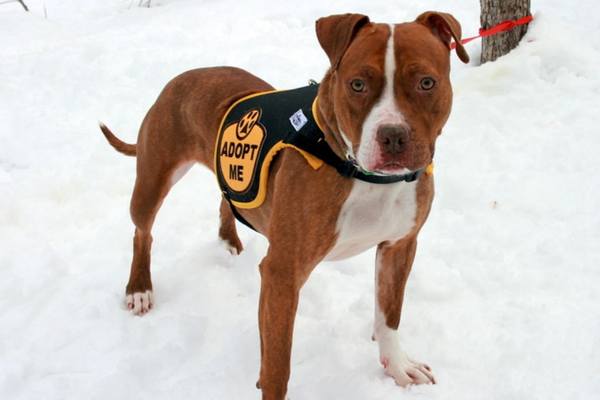
Average Lifespan: 12-15 years
Average Size: 30-60 pounds
Coat: short, smooth
Bred in England as fighting dogs, the intense prey drive of the Pit Bull breed is likely the result of years of training and conditioning as attack dogs.
Although Pit Bull’s can be raised to be gentle, loving, and sociable, for many generations they have not been encouraged by owners to develop these qualities, but rather to be combative and aggressive.
That said, Pit Bull’s respond well to training, as they are intelligent and always eager to please their masters. Early instruction and socialization are necessary to ensure the prey drive of the Pit Bull breed doesn’t become destructive.
2. Chihuahua
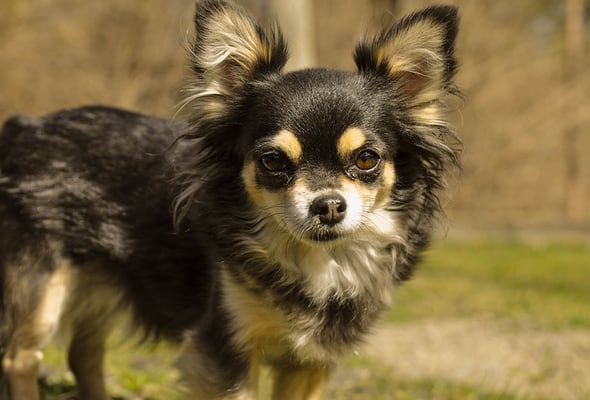
Average Lifespan: 14-16 years
Average Size: 6 pounds or fewer
Coat: short, medium, smooth
The chihuahua can be traced back to the ancient kingdoms of the pre-columbian era. While the modern-day chihuahua has a reputation for lap-doggery, the breed is more than capable of putting in a hard day’s work. They have spent generations honing their considerable prey drives as ratters.
For obvious reasons, a chihuahua doesn’t typically chase large animals, but as one of the dogs with high prey drive, they will act on their instinctive desire to chase smaller pets and wildlife if left to their own devices.
3. Siberian Husky
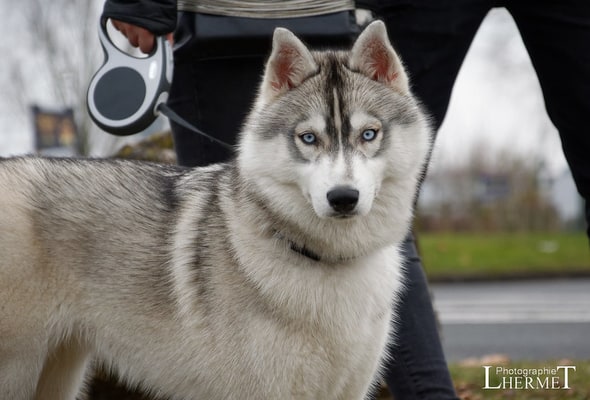
Average Lifespan: 12-14 years
Average Size: 35-60 pounds
Coat: medium, double
The epitome of grace, the Siberian Husky was bred by the Chukchi people of Northeastern Asia for long-distance sledding. With its sleek athleticism, the Siberian Husky breed has proven its utilitarianism time and time again.
The prey drive of the husky breed was born of harsh conditions. In the summertime, Siberian tribes often cut their sled dogs loose to fend for themselves.
Although today’s domesticated huskies are known to be sweet-natured and great with children, early socialization and a close eye is advised to keep them from acting on their instincts and potentially harming other animals.
4. Shiba Inu
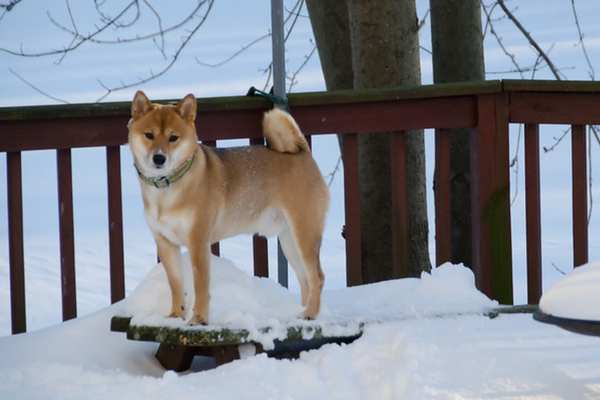
Average Lifespan: 13-16 years
Average Size: 17-23 pounds
Coat: short, double
Following their immortalization as the ‘doge’ meme, the Shiba Inu has skyrocketed in popularity in the United States in recent years. Their compact size and cat-like independence make them an excellent choice for city-dwellers, and their signature ‘Shiba smile’ has the power to charm almost anyone who crosses their path.
That said, this spritely breed was bred to hunt game in the rugged mountains of Japan, and the modern owner who expects the Shiba Inu to sit around and provide meme fodder may have a rude awakening when their dog drags something dead through the door!
5. Beagle
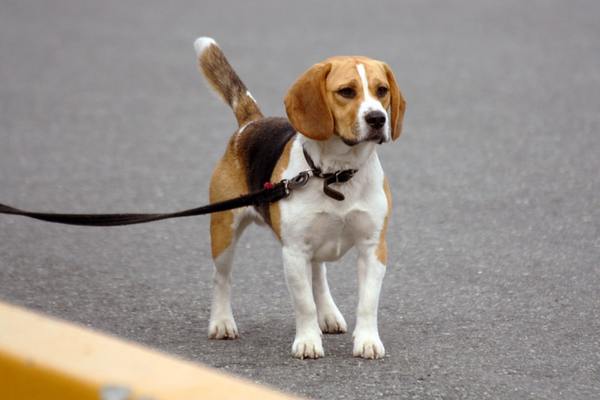
Average Lifespan: 10-15 years
Average Size: 20-30 pounds
Coat: short, smooth
An ancient breed, the Beagle are said to have been employed in England as early as 55 B.C. By the fifteenth century, most English gentlemen owned an early version of the beagle who specialized in hare-hunting. These slightly smaller breeds were the ancestors of the beagle as we recognize them today
With the hunting instinct so firmly entrenched in their DNA, and their sweet-faced, floppy-eared charm, the Beagle is one of the most popular dogs with high prey drive.
6. Irish Wolfhound
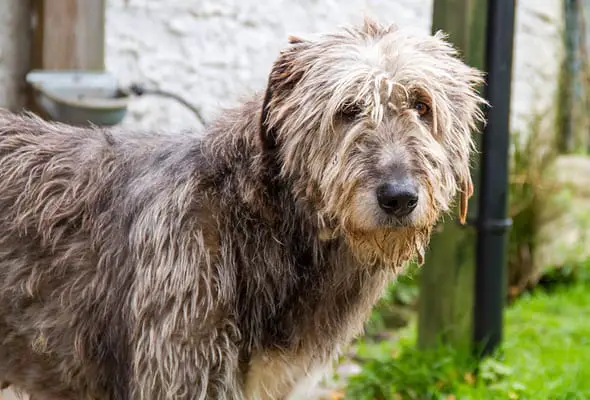
Average Lifespan: 6-8 years
Average Size: 105-120 pounds
Coat: medium, wiry
Bred as big-game hunters as early as fifteenth-century Ireland, the Irish Wolfhound was so effective at this task that they are said to have driven wolves to extinction in Ireland just a few centuries later.
Although still formidable in size and stature (an Irish Wolfhound puppy can weigh up to 100 pounds), the breed of today is known as a serene and agreeable breed. Patient with kids, they make a great family dog, but ought to be closely monitored in the presence of animals their size and smaller.
7. Airedale Terrier
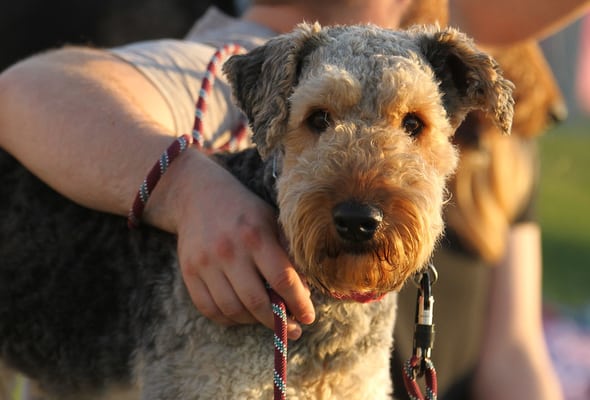
Average Lifespan: 11-14 years
Average Size: 50-70 pounds
Coat: short, medium, wiry
The largest of the terrier breeds, the Airedale were developed in the Aire Valley in Northern England during the industrial revolution. Intended as duck hunters and ratters, Airedales were later employed for their courage and wits as messengers and guard dogs during the first World War.
While notoriously patient with children and good for families, the charmingly-bearded Airedale retains its working spirit and congenitally high prey drive to this day.
8. Bull Terrier
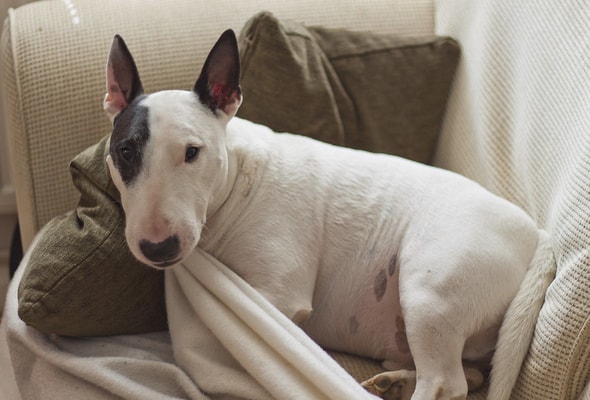
Average Lifespan: 12-13 years
Average Size: 50-70 pounds
Coat: short, smooth
With their unusually shaped heads (sometimes, lovingly, referred to as ‘eggheads’) there are few things cuter than a Bull Terrier, especially as a puppy.
However, the history of the breed is not as innocuous as those sweet dispositions might suggest. The Bull Terrier has a long and storied career as a fearsome competitor in blood sports such as bull-baiting, and later, illegal dogfighting.
Over time, however, breeders have worked to soften the qualities of the Bull Terrier and have succeeded in enhancing the best of the breed. Early training is highly recommended, however, as we all know, old predatory habits die hard!
9. English Springer Spaniel
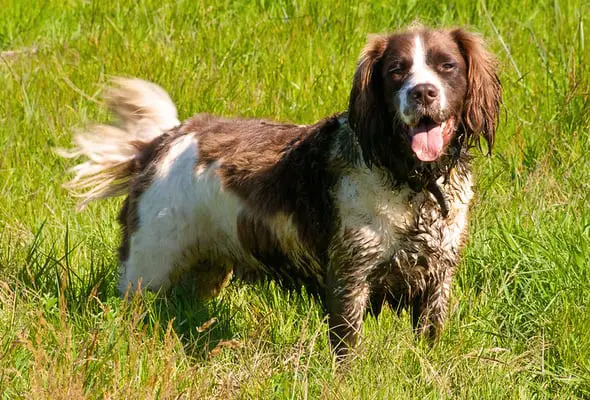
Average Lifespan: 12-14 years
Average Size: 40-50 pounds
Coat: medium, double
The English Springer Spaniel is one of the great all-arounder breeds on this list of dogs with high prey drive. Springer Spaniels love to stay active, which is no surprise considering they were bred to be the most diligent of bird-hunters.
Born to detect game birds in high grass or bramble, they are adept at flushing or “springing” birds from their cover. They have earned a reputation as tireless in this regard, which owners ought to be aware of before letting them off-leash at the park!
10. Jack Russell Terrier
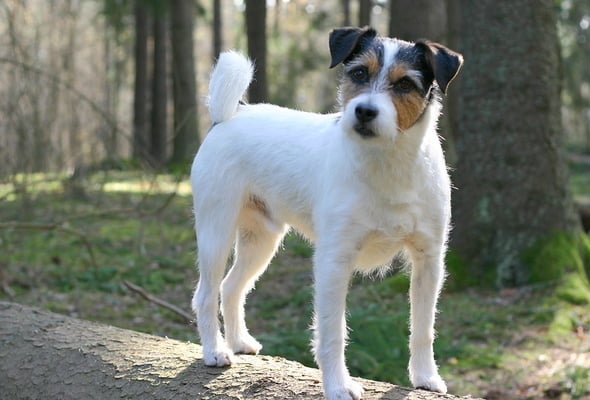
Average Lifespan: 12-14 years
Average Size: 9-15 pounds
Coat: short, wiry, smooth
Developed in England for use in fox hunts, the Jack Russell Terrier has a reputation for industrious and diligent small-game hunting.
Bred by Rev. John “The Sporting Parson” Russell in the eighteenth century, the Jack Russell Terrier is known as the ‘ultimate working terrier’, their size enabling them to burrow into all manner of tight spaces and rabbit holes.
Friendly, intelligent, and playful to boot, the Jack Russell Terrier is highly desirable as a canine companion. Just keep an eye on them around your pet rabbit!
11. Lagotto Romagnolo
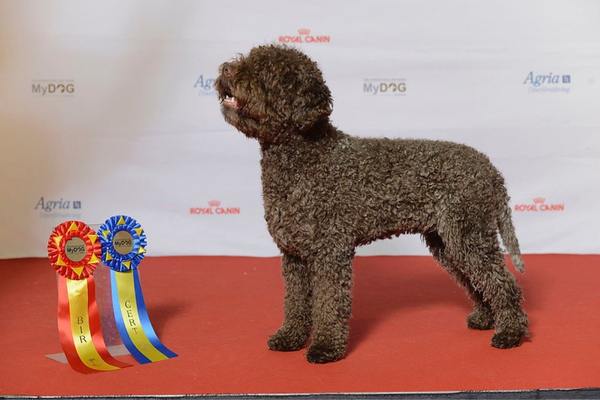
Average Lifespan: 15-17 years
Average Size: 24-35 pounds
Coat: medium, curly, double
The Lagotto Romagnolo, or ‘truffle dog of Italy’ looks like a plush-toy with its wooly curls and is perhaps a surprising inclusion amongst the dogs with high prey drive.
The diminutive stature and glamorous facade of this breed fool many an admirer into assuming they are a simple lap dog, but the Lagotto Romagnolo has a prey drive honed over centuries.
Bred as waterfowl retrievers, their incredible nose led them to become famed as truffle-hunting specialists. Their rare and winsome appearance attracts many a prospective owner, and with them being more likely to hunt truffles than waterfowl these days, their instincts are more delicious than destructive!
12. Leonberger
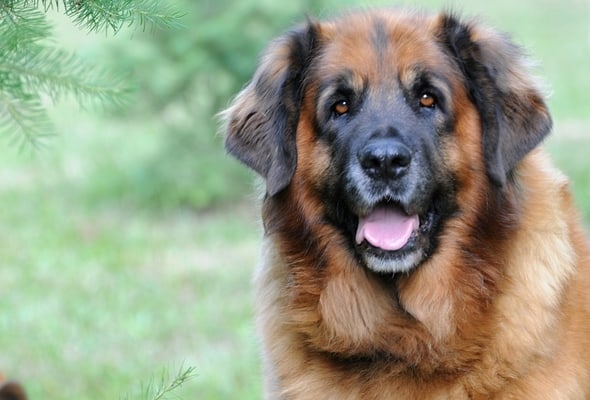
Average Lifespan: 7 years
Average Size: 90-170 pounds
Coat: double, long
The Leonberger is an incredibly striking dog. Onlookers may wonder, Great Pyrenees? Saint Bernard? Wolf? All of the above?
Despite their immense size, dramatic face mask, and the lion-esque ‘mane’ around the neck of the males, the Leonberger is reputed to be a gentle family dog. Their nature comes from their breeding, first and foremost as companion dogs.
Excellent swimmers and remarkably nimble for their size, the Leonberger honed their prey instincts over generations, working as pest-control on farms, pastures and waterfronts.
13. Rottweiler
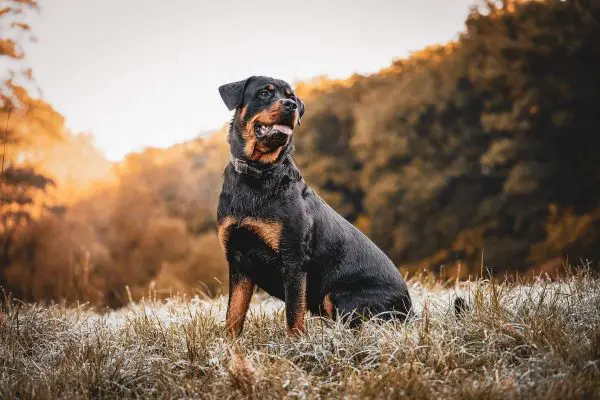
Average Lifespan: 9-10 years
Average Size: 80-135 pounds
Coat: short, smooth
The ancestors of today’s Rottweilers were bred during the Roman Empire to be tough, durable herd-guarding dogs, protecting the food supply of the conquering Roman legions as they traversed. They later found employment as police dogs, guard dogs, and guide dogs for the blind.
Such a prolific working status could not have been accomplished if the breed did not have exceptionally sharp, perceptive instincts, and prey drives. Rottweiler owners must remain vigilant when their Rottie is around smaller dogs.
Many Rottweilers don’t begin displaying a significant prey drive until they’re around two or three years old, so owners must be mentally and physically prepared for the challenge.
14. Basset Hound
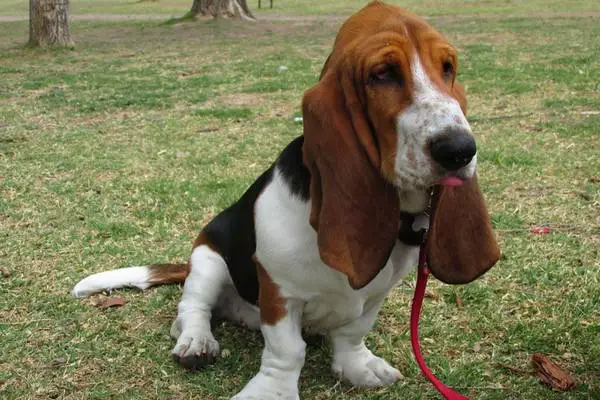
Average Lifespan: 12-13 years
Average Size: 40-65 pounds
Coat: short, smooth
Perhaps the breed that first comes to mind when the phrase ‘hound dog’ is invoked, the Basset has achieved icon status amongst hunting breeds.
With a nose that makes them second only to the Bloodhound, this French/Belgian beauty of a breed is one of the most endearing dogs with high prey drive. Their trademark long ears and doleful expressions belie their tireless, tenacious hunting capacity and enduring quarrying instincts.
15. Afghan Hound
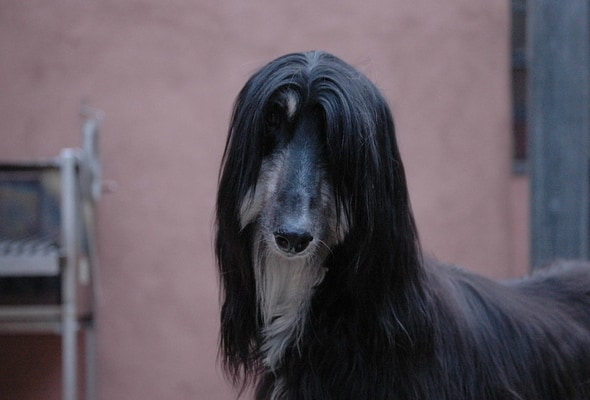
Average Lifespan: 12-18 years
Average Size: 50-60 pounds
Coat: long, silky
Widely regarded as one of the oldest breeds of purebred dogs, the Afghan Hound’s existence predates written history. Revered for their beauty, they were first status symbols among royals, tribal chieftains, and aristocrats in the Asian kingdoms of their origin.
Not just beautiful, Afghan Hounds belong to the subcategory of hound breeds known as sighthounds, dogs who rely on their panoramic vision in the pursuit of prey, and their instinctive prey drives are still vital and intact centuries after they first emerged.
Not to worry, most onlookers at the dog park will be too dazzled by the coat of an Afghan Hound whipping through the breeze to notice whatever small animal it’s picked up in its mouth!
16. Greyhound
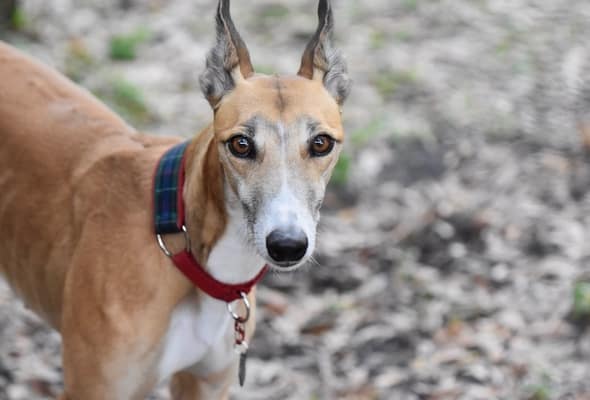
Average Lifespan: 10-13 years
Average Size: 60-70 pounds
Coat: short, smooth
The fastest breed of any dog, the Greyhound originated in Egypt around 5000 years ago. They were bred to detect, chase and capture the wild animals of the desert and modern-day Greyhounds have remained true to these roots.
Typically, a greyhound can live harmoniously around one other dog, but they need to be closely monitored, if not completely kept away from situations involving multiple dogs and animals, as their prey drive may be activated.
They are highly energetic, and vigorous exercise can help a pet greyhound expel these compulsions in a more acceptable manner.
17. Clumber Spaniel
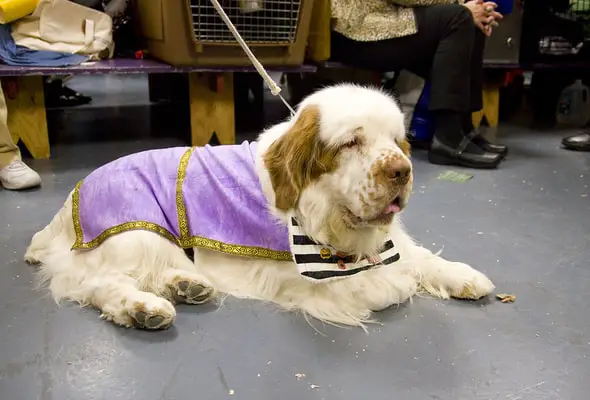
Average Lifespan: 10-12 years
Average Size: 55-85 pounds
Coat: medium, wavy, silky
An unusual beauty and a mellow companion, the Clumber Spaniel is perhaps one of the lesser-known dogs with high prey drive. A favorite of game bird hunters since the seventeenth century, the Clumber is relentless in its pursuit of scent and was built to maneuver through thick field cover with ease.
Today, they are adored by aficionados as affectionate and sometimes mischievous pets, but they are still very prone to give chase at the flutter of a wing or the snap of a twig!

